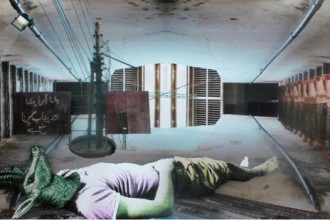By Jay Sizemore
I don’t think viewers can properly prepare themselves for the experience of Jonathan Glazer’s latest film, Under the Skin. The opening sequence is perhaps one of the most riveting and unique things I have ever seen, starting with a black screen that gives way to a single dot of light, perhaps a star, set to a haunting score. It only gets cooler from there. The music and imagery reminded me very much of moments from 2001: A Space Odyssey, and I think this is purposeful, not as homage, but to trigger a reflex memory for those of us who have seen it, a sort of instinctual recall of its elements of dread and awe. Whatever the purpose of this reference, which seems to come from both a visual and auditory place, the impact is dramatic and immediate: it draws you into its hypnotic dance.
After the opening sequence, the movie is more sparsely directed, having the look and feel of an independently made film. Each shot seems to have an interesting perspective compared to the typical framing cinema-goers are accustomed to seeing, which puts the mind in a state of unease as we watch the main character, an unnamed woman played by Scarlett Johansson, go about a rather disturbing routine amidst Scotland’s cold, damp, and dreary landscape. I don’t want to discuss much of the plot, as I feel that would do the film a disservice, but instead I think it’s better to reflect on the possible meanings behind the events.
This is one of those movie-going experiences that initially strikes as so alien, unique and unsettling that you come away in a state of shock, unsure how to process what it is you have just seen. But, upon thought — and believe me, you won’t be able to stop thinking about it — the mind starts piecing it all together and grasping its metaphorical resonance. For this reason alone, this movie should stand out from Hollywood’s usual output for a while.
My main hypothesis is that the film is a study of physical attraction, one that attempts to run through the entire spectrum of human emotion based on this basic instinct found in all people. No matter what we say, the first attraction to a person is generally based solely on their physical appearance, or at least some aspect of it. In the context of the film, this purely physical attraction is a source of power and predation, and in a way that flips the standard Hollywood model, the woman is placed as the predator.
I don’t think I have ever seen a main character played like this, and I don’t think they could have cast a better actress for the role. At a certain point, this character is faced with something that makes her realise she is looking at the world wrong, and she begins to question her actions. This happens during another twist on physical beauty, as her character attempts to seduce a man who has never been found attractive before by anyone else and elicits only pity from the audience. At this moment, the character begins to undergo a series of changes, and in doing so will traverse the rest of the available spectrum of emotions, turning what was once her source of power into a source of misery. The character goes from manipulating others using her physical form to not wanting to attract anyone at all, yet she is unable to avoid the fact of her attractiveness, which ultimately turns her from predator into prey as human instincts prove to be deadly when uncontrolled.
There’s another more eerie and perhaps even sinister subtext to the events that happen, and I won’t go into that for fear of spoiling it for others. Let’s just say that the film’s title, derived from the acclaimed Michel Faber novel on which the film is based, is well-deserved, as this is one that stays under your skin for days after you watch it.
Jay Sizemore is a film critic for the magazine.





